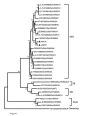Prevalence of hepatitis E virus and porcine caliciviruses in pig farms of Guizhou province, China
- PMID: 22087178
- PMCID: PMC3212798
Prevalence of hepatitis E virus and porcine caliciviruses in pig farms of Guizhou province, China
Abstract
Background: Hepatitis E virus (HEV) and caliciviruses are enteric pathogens of humans and animals, and pigs have been considered an important reservoir of these viruses.
Objectives: The aim of this study is to determine the infection rates of HEV and caliciviruses (sapovirus [SaV] and norovirus [NoV]) in different age groups of pigs in Guizhou province, China, and characterize the strains that are prevalent in this mountainous area.
Materials and methods: A total of 209 stool samples from healthy pigs of different ages were collected from 6 pig farms in Guizhou province from May to June 2009 and tested for HEV, SaV, and NoV by reverse-transcription polymerase chain reaction (RT-PCR).
Results: The overall prevalence of porcine HEV and porcine SaV was 6.7% (15/209) and 1.0% (2/209), respectively. No NoV was detected. The prevalence rates of porcine HEV infection were 15.4% in piglets aged < 1 mon (4/26), 6.8% in piglets aged between 1 and 4 mon (3/44), 12.5% in piglets aged ≈ 4 mon (6/48), and 1.1% in sows aged between 6 and 14 mon (2/91). Porcine SaV was detected only in piglets (7.7%, 2/26). All 10 HEV isolates belonged to genotype 4, clustering with a human HEV strain (AF103940) from an adjacent province.
Conclusions: This is the first report on the existence of porcine SaV in swine in Guizhou province, China. The clustering of the porcine HEV isolates with a human strain suggests cross-species transmission between swine and humans in this area.
Keywords: Caliciviruses; Genetic diversity; Hepatitis E virus; Porcine.
Conflict of interest statement
Figures



Similar articles
-
Molecular detection and prevalence of porcine caliciviruses in eastern China from 2008 to 2009.Arch Virol. 2009;154(10):1625-30. doi: 10.1007/s00705-009-0487-5. Epub 2009 Sep 11. Arch Virol. 2009. PMID: 19763779
-
Prevalence of hepatitis E virus and sapovirus in post-weaning pigs and identification of their genetic diversity.Arch Virol. 2008;153(4):739-42. doi: 10.1007/s00705-008-0046-5. Epub 2008 Feb 9. Arch Virol. 2008. PMID: 18264659
-
Prevalence of hepatitis E virus (HEV) infection in various pig farms from Shaanxi Province, China: First detection of HEV RNA in pig semen.Transbound Emerg Dis. 2019 Jan;66(1):72-82. doi: 10.1111/tbed.12966. Epub 2018 Jul 24. Transbound Emerg Dis. 2019. PMID: 30043495
-
Prevalence of hepatitis E virus among swine in China from 2010 to 2019: A systematic review and meta-analysis.Microb Pathog. 2021 Jan;150:104687. doi: 10.1016/j.micpath.2020.104687. Epub 2020 Dec 8. Microb Pathog. 2021. PMID: 33301857
-
The Complexity of Swine Caliciviruses. A Mini Review on Genomic Diversity, Infection Diagnostics, World Prevalence and Pathogenicity.Pathogens. 2022 Mar 29;11(4):413. doi: 10.3390/pathogens11040413. Pathogens. 2022. PMID: 35456088 Free PMC article. Review.
Cited by
-
Seroprevalence and molecular detection of porcine sapovirus in symptomatic suckling piglets in Guangdong Province, China.Trop Anim Health Prod. 2014 Mar;46(3):583-7. doi: 10.1007/s11250-013-0531-z. Epub 2014 Jan 10. Trop Anim Health Prod. 2014. PMID: 24407531
-
Porcine sapoviruses: Pathogenesis, epidemiology, genetic diversity, and diagnosis.Virus Res. 2020 Sep;286:198025. doi: 10.1016/j.virusres.2020.198025. Epub 2020 May 26. Virus Res. 2020. PMID: 32470356 Free PMC article. Review.
-
From the epidemiology of hepatitis E virus (HEV) within the swine reservoir to public health risk mitigation strategies: a comprehensive review.Vet Res. 2017 May 25;48(1):31. doi: 10.1186/s13567-017-0436-3. Vet Res. 2017. PMID: 28545558 Free PMC article. Review.
-
Farm-level prevalence and risk factors for detection of hepatitis E virus, porcine enteric calicivirus, and rotavirus in Canadian finisher pigs.Can J Vet Res. 2016 Apr;80(2):95-105. Can J Vet Res. 2016. PMID: 27127336 Free PMC article.
-
Swine Norovirus: Past, Present, and Future.Viruses. 2022 Mar 5;14(3):537. doi: 10.3390/v14030537. Viruses. 2022. PMID: 35336944 Free PMC article. Review.
References
-
- Panda SK, Thakral D, Rehman S. Hepatitis E virus. Rev Med Virol. 2007;17(3):151–80. - PubMed
-
- Huang FF, Haqshenas G, Guenette DK, Halbur PG, Schommer SK, Pierson FW, Toth TE, Meng XJ. Detection by reverse transcription-PCR and genetic characterization of field isolates of swine hepatitis E virus from pigs in different geographic regions of the United States. J Clin Microbiol. 2002;40(4):1326–32. - PMC - PubMed
-
- Ijaz S, Arnold E, Banks M, Bendall RP, Cramp ME, Cunningham R, Dalton HR, Harrison TJ, Hill SF, Macfarlane L, Meigh RE, Shafi S, Sheppard MJ, Smithson J, Wilson MP, Teo CG. Non-Travel-Associated Hepatitis E in England and Wales: Demographic, Clinical, and Molecular Epidemiological Characteristics. J Infect Dis. 2005;192(7):1166–72. - PubMed
-
- Lu L, Li C, Hagedorn CH. Phylogenetic analysis of global hepatitis E virus sequences: genetic diversity, subtypes and zoonosis. Rev Med Virol. 2006;16(1):5–36. - PubMed
LinkOut - more resources
Full Text Sources
